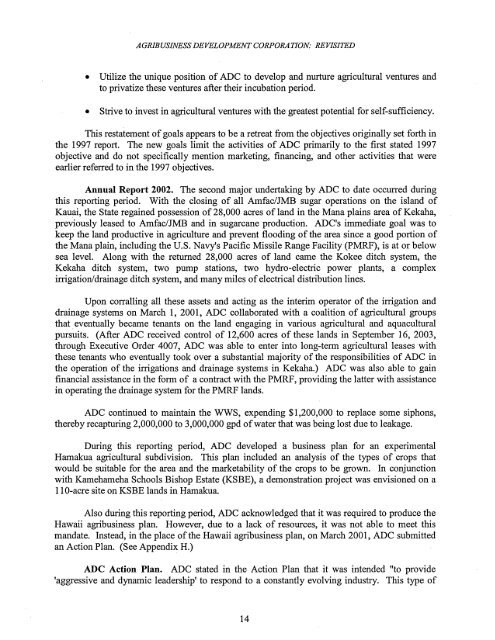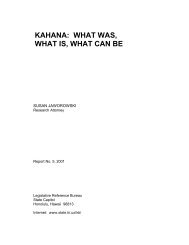agribusiness development corporation: revisited - Legislative ...
agribusiness development corporation: revisited - Legislative ...
agribusiness development corporation: revisited - Legislative ...
Create successful ePaper yourself
Turn your PDF publications into a flip-book with our unique Google optimized e-Paper software.
AGRIBUSINESS DEVELOPMENT CORPORATION- REVISITED<br />
• Utilize the unique position of ADC to develop and nurture agricultural ventures and<br />
to privatize these ventures after their incubation period.<br />
• Strive to invest in agricultural ventures with the greatest potential for self-sufficiency.<br />
This restatement of goals appears to be a retreat from the objectives originally set forth in<br />
the 1997 report. The new goals limit the activities of ADC primarily to the first stated 1997<br />
objective and do not specifically mention marketing, financing, and other activities that were<br />
earlier referred to in the 1997 objectives.<br />
Annual Report 2002. The second major undertaking by ADC to date occurred during<br />
this reporting period. With the closing of all Amfac/JMB sugar operations on the island of<br />
Kauai, the State regained possession of 28,000 acres of land in the Mana plains area of Kekaha,<br />
previously leased to Amfac/JMB and in sugarcane production. ADC's immediate goal was to<br />
keep the land productive in agriculture and prevent flooding of the area since a good portion of<br />
the Mana plain, including the u.S. Navy's Pacific Missile Range Facility (PMRF), is at or below<br />
sea level. Along with the returned 28,000 acres of land came the Kokee ditch system, the<br />
Kekaha ditch system, two pump stations, two hydro-electric power plants, a complex<br />
irrigation/drainage ditch system, and many miles of electrical distribution lines.<br />
Upon corralling all these assets and acting as the interim operator of the irrigation and<br />
drainage systems on March 1, 2001, ADC collaborated with a coalition of agricultural groups<br />
that eventually became tenants on the land engaging in various agricultural and aquacultural<br />
pursuits. (After ADC received control of 12,600 acres of these lands in September 16, 2003,<br />
through Executive Order 4007, ADC was able to enter into long-term agricultural leases with<br />
these tenants who eventually took over a substantial majority of the responsibilities of ADC in<br />
the operation of the irrigations and drainage systems in Kekaha.) ADC was also able to gain<br />
financial assistance in the form of a contract with the PMRF, providing the latter with assistance<br />
in operating the drainage system for the PMRF lands.<br />
ADC continued to maintain the WWS, expending $1,200,000 to replace some siphons,<br />
thereby recapturing 2,000,000 to 3,000,000 gpd of water that was being lost due to leakage.<br />
During this reporting period, ADC developed a business plan for an experimental<br />
Hamakua agricultural subdivision. This plan included an analysis of the types of crops that<br />
would be suitable for the area and the marketability of the crops to be grown. In conjunction<br />
with Kamehameha Schools Bishop Estate (KSBE), a demonstration project was envisioned on a<br />
1 IO-acre site on KSBE lands in Hamakua.<br />
Also during this reporting period, ADC acknowledged that it was required to produce the<br />
Hawaii <strong>agribusiness</strong> plan. However, due to a lack of resources, it was not able to meet this<br />
mandate. Instead, in the place of the Hawaii <strong>agribusiness</strong> plan, on March 2001, ADC submitted<br />
an Action Plan. (See Appendix H.)<br />
ADC Action Plan. ADC stated in the Action Plan that it was intended "to provide<br />
'aggressive and dynamic leadership' to respond to a constantly evolving industry. This type of<br />
14
















